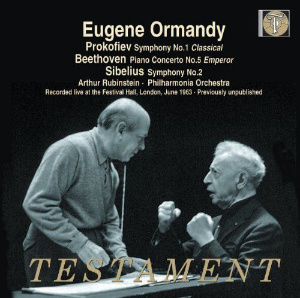
Sergei Prokofiev (1891-1953)
Symphony No. 1 in D, Op. 25 (Classical) (1916-17)
Ludwig van Beethoven (1770-1827)
Piano Concerto No. 5 in E-flat, Op. 73 (Emperor) (1809)
Jean Sibelius (1865-1957)
Symphony No. 2 in D, Op. 43 (1901-2)
Artur Rubinstein (piano)
Philharmonia Orchestra/Eugene Ormandy
rec. live, June 1963, Royal Festival Hall
TESTAMENT SBT21503 [51+43]
Look closely at the headnote: it’s not the Philadelphia Orchestra on tour, but the Philharmonia at home. This concert marked a relatively rare guest appearance by Eugene Ormandy, and in tandem with Artur Rubinstein, at that. (At the time, the two had mutually exclusive recording contracts: Ormandy with Columbia, Rubinstein with RCA.) While the concert went over well — the audience gave it a nice ovation — it also serves as an object lesson in the importance of the interactions between the conductor and his or her players: conductorial expertise and insight don’t, by themselves, produce the performances.
The Classical Symphony exemplifies both the advantages and the problems inherent in the guest-conducting situation. On his home turf, Ormandy was inclined to play the piece for virtuosity, underlining the uniquely rich sounds of his orchestra. The Philharmonia, too, had a warm basic sound, but thicker, less purposeful. The orchestra copes well with Ormandy’s speedy first movement, though the opening flourish is a bit of a blur. In the Larghetto, however, the woodwinds bungle their solo entries, briefly producing chaos; the orchestra rights itself at the next tutti, but nerves cause the players to push the ensuing semiquaver figures ahead. Wisely, a longer pause between movements allows everyone to settle back down, and the moderately paced Gavotta and tensile Finale are successful.
Hearing Artur Rubinstein in the cadenza-like opening flourishes that launch the Emperor Concerto — crisply articulated, with a lovely bell-like resonance — made me wonder: has any other pianist projected such sheer relish in the act of playing? I found it impossible not to respond to his musicality and exuberance, even if his impulsiveness gets the better of him; there are a number of small splatters later on, and a more conspicuous one heading into the first movement’s final cadence. The central Adagio is flowing and cantabile, if never quite reposeful, and the concluding Rondo has an infectious, bounding exuberance.
Ormandy, who seems never to have figured in the Emperor‘s stereo discography, leads a big, extroverted accompaniment. Ensemble is frequently slightly loose, and the conductor and orchestra don’t quite dovetail with the soloist’s big run ushering in the recapitulation. In parts of the Rondo, the strings occasionally produce an impressive, buzzy resonance.
As for the Sibelius symphony, I suspect the performance didn’t sit well with either Ormandy or the players. The first movement resembles the conductor’s studio recordings, but the orchestra sounds discomfited by the intense attacks in the development, and the last whirling string figure in the recap is another blur (though the parallel one in the exposition was fine). In the Tempo andante‘s restatement, trumpet and flute both have trouble aligning their solos with the uneasy violin triplets. The strings dig into the rapid figures of the Vivacissimo with full-bodied gusto – these are the most successfully Philadelphia-like passages – but the waspish, unattractive oboe mars both trios. The Finale begins forthrightly, but the exaggerated ritard after the first half nearly makes it grind it to a halt. If you listen carefully, the woodwinds keep pulling ahead of the big tune in the tuttis; the movement as a whole sounds cluttered.
The original BBC recording, while monaural, comes across vividly in Paul Baily’s remastering, despite some mild woodwind discoloration and some grain in the upper strings.
Stephen Francis Vasta
stevedisque.wordpress.com/blog
Help us financially by purchasing from




















